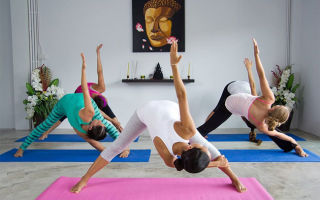Content
- 1 What is yoga and where did it come from
- 2 Varieties of yoga
- 3 The benefits of yoga for women
- 3.1 Improves the work of the hormonal system
- 3.2 Strengthens the immune system
- 3.3 Helps Fight Overweight
- 3.4 Helps Relieve Stress and Depression
- 3.5 Improves sleep
- 3.6 Rejuvenates
- 3.7 Develops flexibility
- 3.8 Relieves headaches
- 3.9 Reduces blood sugar and cholesterol levels
- 3.10 Relieves pain during menstruation
- 3.11 Helps to get pregnant
- 4 Is it possible to do yoga during pregnancy
- 5 Is yoga good for kids
- 6 Yoga rules for beginners
- 7 When and where to do yoga
- 8 Exercises for beginners at home
- 9 Contraindications to yoga
- 10 Conclusion
- 11 Reviews
Outside India, the term "yoga" is often associated only with the practice of hatha yoga and its asanas - physical exercises: such a concept does not reflect the essence of the system. Yoga in translation from Sanskrit literally means "exercise", "connection", "harmony". The name speaks for itself, however, with all its popularity, the benefits and harms of yoga as a system of healing the body is largely determined by how fully its full potential is used.
What is yoga and where did it come from
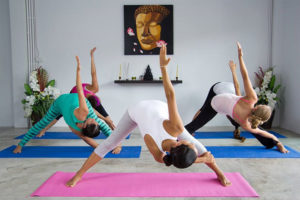
The ancient Indian hymns of the 11th century Rig Veda are considered the first mentions of yoga. BC e. And the description of the yoga system as an eight-step practice for a person to understand his perfect essence was presented to the world by the Indian philosopher Pantajali.
The eight steps of yoga represent eight successive levels, mastering which allows the student to achieve liberation from earthly sufferings and enter a state of peak energy capabilities.
- The first two steps of yoga - yama and niyama - constitute the ethical foundations of yoga, the development of which lays the spiritual basis for the further performance of asana exercises. This includes five spiritual principles: do not harm living beings, refrain from stealing, lying, sexual lust and possession of unnecessary things.
- At the third stage of yoga - hatha - the practitioner masters asanas that develop the ability to concentrate on the sensations of the body, help to remove physical and mental clamps - to activate the movement of energy in the channels. The main goal of the practice of the third step of yoga, the most popular in the West, is not just to train the body, but also to connect with it by directing attention and mastering the skill of controlling one's somatic.
- At the fourth stage of yoga - pranayama - the student masters the practice of controlling the breath, and through it - the primary energy - prana. Special techniques based on the alternation of deep and shallow breathing, as well as its retention and direction through the body, allow the practitioner to accumulate vital energy for its subsequent conscious use.
- On the fifth step of yoga - pratyahara - the adept learns to distract the sense organs from the objects of the world and to maintain the state of consciousness in the "here and now" mode - a way to perceive events without evaluations.
- Passage of the sixth stage - dharana gives a useful quality of complete concentration of the mind on the chosen object. It is believed that keeping the mind completely focused on one object for 12 seconds allows you to go to the seventh level - dhyana, on which the comprehension of one's own existence takes place through concentration on the inner world.
- Samadhi is the name of the last, eighth step of yoga, the practices of which reveal the ability of consciousness to perceive the integrity of oneself and the world, to completely go beyond the bounds of the limited mind: it is in this state that access to boundless vital energy appears.
Knowledge of the steps of yoga is especially important in light of the mass enthusiasm for its applied side, on the basis of which methods have been developed for the benefits of losing weight, restoring the spine and other health purposes. The system of yoga practices has a more powerful potential impact: to improve not only physical, but also mental health, as well as life in general - thanks to the liberation of consciousness from fuss and anxiety, the ability to listen and hear your body, your spirit, go into a state of flow with its endless possibilities.
Varieties of yoga
The rapidly growing popularity of yoga has opened up a wide variety of directions: from the simplest to the advanced practices. The most popular ones are:
- Hatha yoga... Studies in the United States have proven the benefits of yoga asanas for stress relief, as evidenced by the results of women exercising up to twice a week. It is better to start the practice with the classical foundations developed by the master Swami Swatmarama: he combined basic hatha asanas with breathing exercises of pranayama, meditation, mudras (gestures) and diet.
- Yin yoga... As the name suggests, it is a “feminine,” calm practice designed to relax the body and release clamps. Asanas are performed in a comfortable sitting position, lying down at a smooth pace, with meditative music. In each pose, up to 5 minutes are delayed, with an important emphasis on breathing.
- Yoga nidra... Translated as sleep yoga. This direction of yoga is also called "mental sleep", or "sleep of yogis" - a state that is achieved by the one-pointed work of the mind through the distraction of the senses in turn from the objects of the external world. The practice of Nidra is realized through entering a borderline state of consciousness and is a powerful method of relaxation, during which the nuclei and centers of the brain are restored, so the benefit lies in its ability to relieve stress and mental blocks, frustration states, release the energy of suppressed desires - gently and without harm for a person. An hour of this yoga practice replaces four hours of regular sleep and more than one session of psychotherapy.
- Bandhi yoga... The translation of the name from Sanskrit reflects the nature of the exercises: "binding", "locking", that is, clamping, bringing to hypertonicity of muscle groups, followed by their relaxation. In the course of this yoga practice, bodily and mental relaxation and a beneficial effect on the hormonal, respiratory, cardiovascular and other systems of the body are achieved.
In addition to classical practices, there are many modern active directions that can be performed in a dynamic mode (for example, Ashtanga Vinyasa - a mixture of yoga with aerobics) or in a power mode (Power yoga, combined with cardio loads). There are even yoga practices for women who walk in heels.
The list of varieties of yogic practices is large, and the choice will depend on the individual characteristics of a person, his state of health and even age and gender.
The benefits of yoga for women
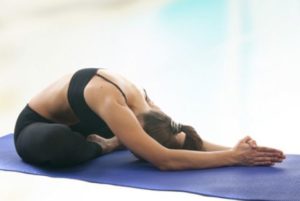
The possibilities of yoga allow you to selectively approach physiology: thanks to this, women's practices stand as a separate area, the use of which lies in taking into account the structural features of the female body and the specifics of the hormonal system.
Improves the work of the hormonal system
A woman's hormonal background is regulated by 60 hormones. The work of this system is subtle: even small fluctuations in the ratio of hormone production by the glands have noticeable changes in the functioning of the whole organism.The beneficial effect of yoga practices is the ability to debug hormones without the use of medication, and this seems fantastic.
Yoga classes have a beneficial effect on the endocrine system at the level of the hypothalamus - pituitary gland - ovaries. When these links are synchronized, the secretions secreted by the glands into the blood and lymph allow the body's biochemical reactions to proceed normally. The imbalance in their work can be immediately identified by a change in the emotional state and behavior of a woman. So, the harm of a lack of thyroid hormones is manifested by hysterical reactions.
An experienced yoga instructor will help you choose a training program based on the individual characteristics of the woman's health and condition.
The benefits of normalizing the pituitary gland are achieved through the practice of relaxation, which in turn activates blood circulation in the head. To solve this problem, the beneficial properties of inverted asanas, visualization of yoga nidra, meditation and the soothing breath of pranayama are good.
Asanas are beneficial to stabilize the hormonal background:
- Bhujangasana (Cobra pose).
- Shirshasana - (headstand).
- Tolasana (Libra pose).
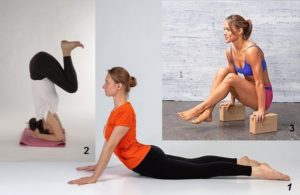
In addition, the restoration of hormonal levels is helped by:
- yoga nidra techniques;
- bandhas: uddiyana (abdominal retraction); Mula Bandhi (Root Lock Pose performed by squeezing the muscles of the perineum);
- pranayama exercises: Nadi-shodhana (cleansing the channels - breathing in turn through the left and right nostrils; Kapalabhati ("Cleaning the skull" - rapid breathing with the stomach).
Strengthens the immune system
The state of immunity determines the work of the lymphatic system and spleen, in particular, in the synthesis of immunoglobulins and antibodies. Lymph nodes serve as filters for bacteria that are harmful to the body. And it is the lymphatic system that needs to engage the muscles of the body, in particular through the physical and breathing exercises of yoga. The normalization of the immune system will benefit from yoga poses with a head position below the heart.
A complex of asanas of hatha yoga will have a beneficial effect on the immune system:
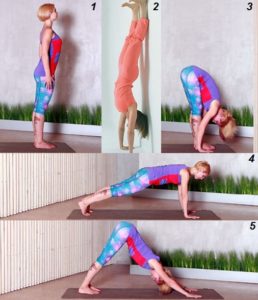
- Tadasans (Mountain Poses).
- Urdhva Vrikshasana (Inverted Tree Poses - Handstands).
- Uttanasana (Feet Bend Poses).
- Chaturango Dandasana (Staff Poses - variations of the "plank").
- Adho Mukha Shvanasanai (Downward Dog Poses).
Helps Fight Overweight
The benefits of yoga, in contrast to fitness and running, are aimed not so much at combating the consequences of unhealthy habits - burning fat and others, as at eliminating the causes of the appearance of extra pounds: improper metabolism, hormonal disruption, the harm of exposure to stress factors. In this regard, the effect of yoga practice will be long-term.
A set of poses aimed at burning excess fat on the waist, hips, strengthening the muscles of the legs, buttocks and the press will be useful for losing weight, each of which is performed for a minute in three sets.
Standing practice:
- Trikonasana (Elongated Triangle Pose).
- Virabhadrasana I (Warrior pose).
- Ardha Chandrasana (Crescent Moon Pose).
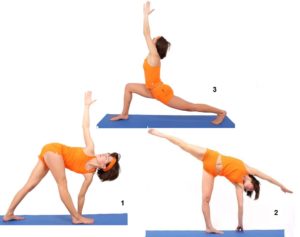
Practice on the floor:
- Paripurna and Ardha Navasana (half Boat pose).
- Chaturanga Dandasana (Staff Poses).
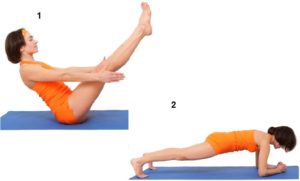
From the exercises of pranayama, the practice of Kapalabhati (Fire Breathing of the Abdomen) will be beneficial.

Since bad habits are formed for a long time, it will also take at least a year of yoga practice to eliminate them by influencing deep processes. An integrated approach will bring the benefits of accelerating the formation of a slender figure: supplementing yoga practices with diet correction and dynamic physical activity (jogging, fitness, etc.).
Helps Relieve Stress and Depression
The best argument for the anti-stress benefits of yoga practice is the research results: for example, psychiatrists at the University of California found that three times a week for 2 months completely eliminate depressive conditions.
It will be useful to perform a complex of standing poses:
- Setu Bandhasana (Bridge posture - resembles the exercise "half-bridge").
- Urdhva Mukha Shavanasana (Upward-facing Dog Poses).
- Yana Shirshasana (head tilt posture).
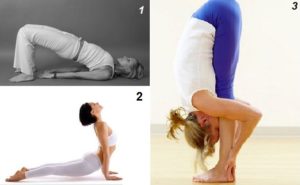
Practices lying on the floor:
- Yoga Nidras in Savasana (Dead Body Poses);
- Ujayi pranayama (snake breathing: deep in and out).
Improves sleep
Relaxing yoga poses will also be helpful in promoting sleep and breathing. Their benefit lies primarily in the activation of the parasympathetic nervous system.
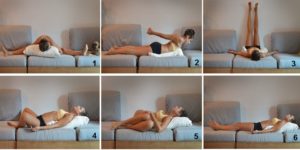
The practice of six yoga asanas will help to tune in to the wave of sleep:
- Upavishtha Konasana - Staff poses.
- Salabhasanas (Locust postures).
- Viparita Karani (bent candle pose).
- Supta Baddha Konasana (Butterfly lying position).
- Yathara Parivartanasana (Lateral Twisting Poses).
- Savasana (Dead Body Poses).
Rejuvenates
The best motivation to use the rejuvenating effects of the exercise is the beautiful form of such unfading yoga fans as, for example, Madonna and Julia Roberts.
Indeed, such an omnipotence of yoga practice lies in its regenerating effect, which, of course, is associated with a complex of effects on the immune system and the hormonal system, on improving the blood supply to organs and tissues. Yoga practices will not slow down to affect the skin and general body tone, and will also benefit from the most gentle passage of menopause for women after 40, and to maintain excellent condition in old age.
First of all, inverted poses are known for beneficial anti-aging effects:
- Sarvangasana ("birch");
- Viparita-Karani Mudra (the bent candle pose - as an incomplete version of the "birch", when the hips rest on the hands behind the back).
Further, the practice of a group of asanas of restorative action will be beneficial:
- Supta-Baddha Konasana (Butterfly lying position).
- Setu Bandhasana (postures of the Bridge, or half-bridge).
- Balasans (child poses).
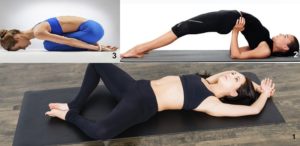
The poses are performed gently and unhurriedly to prevent harm to muscles, joints, and bones.
Develops flexibility
The almost limitless arsenal of yoga asanas can be used to develop flexibility. The advantages of the practice lie in its useful reference to the absence of tension, which, with proper preparation, does not harm the injury of body tissues.
Therefore, beforehand, it is recommended to warm up with the help of dynamic yoga articular gymnastics - sukcham kriya. Next, it will be useful to perform simple breathing techniques of pranayama with a gradual "stretching" of inhalation and exhalation. The resulting feeling of relaxation will create the desired "fluid" state, which will, as it were, merge into the performance of the asana. Yoga classes end with relaxation in Shivasan (dead man's pose) - to neutralize any possible clamps and tension.
Relieves headaches
To relieve headaches, you should start by removing the general tension. Here, the use of Nadia's technique will be very useful - for cleansing the channels. So, the practice of a simple Nadi Shodhana consists in alternately inhaling one nostril and a slower (twice as long) exhalation through the other (the non-working nostril is clamped by the hand). Performing the exercise methodically will help ease the pain.
Video tutorial of the practice of entry-level yoga asanas to eliminate headaches:
Reduces blood sugar and cholesterol levels
With diabetes mellitus, a complex of twists, deflections and inverted poses works. The result of a group of subjects who, after a three-month course of yoga classes, brought the blood formula back to normal, was recorded.In addition, for diabetes mellitus and excess blood cholesterol, experts recommend practicing "hot yoga" (bikram yoga). You can normalize the blood composition with a complex of asanas:
- Ardha Matsyendrasa (Back Twist Poses).
- Ardha Gomukhasana (Cow's Head Pose).
- Vajrasana (Diamond Poses).
- Pashchimottanasans (buttock stretch postures).
- Virabhadrasana (Warrior Poses).
- Malasans (garland poses).
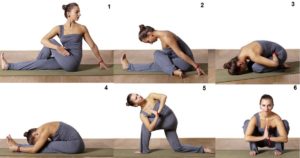
Relieves pain during menstruation
Premenstrual syndrome is often the body's response to stressors. When working with this problem, yoga positions are chosen from the practice that increase the production of antidepressant hormones.
A useful effect in the debugging of the menstrual cycle will bring regular practice of the already familiar postures of Sarvangasana ("birch trees") and Viparita Karani (Bent candle), as well as Halasana (Plow posture), which lower the secretion of estrogen.
On critical days, on the other hand, inverted asanas are replaced with ones that lower estrogen production.
With abundant discharge, it will be beneficial to do:
- Chandrasana (Crescent Pose).
- Utthita Hasta Padangushthasana (Outstretched Hand Poses).
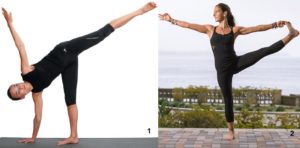
For menstrual cramps, the above-mentioned Supta Baddha Konasana (Butterfly Lying Pose) will be useful.
Helps to get pregnant
Yoga practice should be started even before conception in order to comprehensively prepare the body for pregnancy and childbirth. First of all, familiar asanas are performed, which help to normalize blood circulation in the pelvic region.
- Viparita Karani (bent candle pose) - it is better to perform it with your feet against the wall;
- Setu Bandha Sarvangasana (Bridge pose, or "half bridge").
The second group of yoga poses mentioned above helps to expand the space in the pelvic area and relieve tension:
- Salamba Baddha Konasana (Butterfly lying position);
- Shavasanas (postures of the dead body).
The practice of the third group of yoga asanas will benefit in general stimulation of the blood circulation in the reproductive system:
- Pashchimottanasans (Poses of Bending forward to the knee).
- Hastapadasans (stork poses, or tilt to the legs).
- Janu Shirshasana (Head knee poses).
- Urdhva Dhanurasana (bow posture, or "bridge").
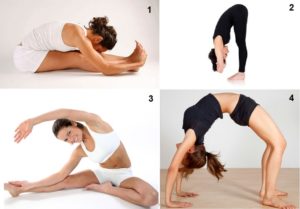
Is it possible to do yoga during pregnancy
The benefits of yoga practice is to strengthen the uterus of a pregnant woman, so that later the process of childbirth can be normal. Visits to specialized yoga groups are shown, where the training program is built in accordance with the specific needs of the female body during this period.
During postpartum rehabilitation, the practice of removing the tone of Shavasana (Dead Man's pose) and Ujayi Pranayama (Hissing Breath) is shown.
You can master hissing breath from the video tutorial:
Is yoga good for kids
The child's body, like the psyche, is more flexible and pliable to yoga classes, since it practically has no blocks. For children, the benefit of yoga practice is in teaching them to love the exercise and the ability to listen to their body: for this they need to help pay attention to the area that is strained in the asana.
By the age of 10 - 15 years, against the background of the development of the reproductive system, the body is subject to hormonal fluctuations. The arsenal of yoga means can also remove the instability of the psycho-emotional sphere associated with these processes, which adolescents are so exposed to.
The practice of inverted asanas, bending back and forth, will be beneficial for stimulating the pituitary gland and ensuring blood flow to the abdominal organs. In addition, yoga classes will help in the formation of the correct development of the musculoskeletal system, prevent the harm of the consequences of scoleosis and other spinal problems.
Yoga rules for beginners
The rules for classes are indicative in nature, since the practice of yoga is very dependent on the individual characteristics of the organism. General recommendations may apply to:
- Food before and after yoga. Yoga practice should be performed on a light stomach: food intake should be no later than two hours before classes.After classes, it is enough to wait half an hour: the body needs a smooth transition to a new type of energy that food provides.
- Drinking... Drinking water is encouraged, but not during asanas. However, pranayama requires limiting water intake before class. An exception may be a small amount of hot or warm liquid.
- Water procedures... Taking a warm or cool shower before yoga is helpful. You don't need a shower after classes, unless you have performed dynamic practices, after which sweating is possible. Taking a hot bath or sauna (both before and after the session) can negate all the benefits of yoga practice.
- Newbie mistakes... One should not strive to perform the asanas "ideally" or perform complex twists at once: it is more important to learn to find "contact" with the sensations of the body. It is better to start any yoga posture with a lightweight version, gradually, as the muscle relaxes, increasing the depth of the asana.
Important! It is possible to get harm from injuring muscles and ligaments in asana practice only if you ignore the sensations and prompts of your body.
- Food quality... As you practice yoga, the body itself will require changes in the menu, especially if heavy foods are present in the diet. Better to focus on fresh, organic food, with judicious spice additions as natural supplements.
When and where to do yoga
To start yoga classes, it is better to enroll in a group for beginners. In order to then decide which direction is suitable, it will be useful to test visits to yoga groups of various directions.
The benefits of yoga are not limited: if you want, you can practice even every day. In a week, a frequency of 2 - 3 sessions will be useful, with an average duration of 1 hour, and practices with a frequency of 3 - 4 times will become optimal in terms of productivity.
It will be possible to switch to independent yoga classes after mastering the basic techniques from an experienced master and building an approximate individual program.
Vigorous physical exercises of hatha yoga are best done in the morning, while pranayama breathing practices and meditation sessions are beneficial at any time of the day.
Exercises for beginners at home
For beginners, simple yoga exercise techniques are recommended that, for all their simplicity, can have powerful effects on the body. The benefits of the soft effect of the practice on the joints are especially important at the very beginning - to prevent the harm of their injury and the gradual preparation of muscles and ligaments for subsequent levels of yoga, with postures of twisting, bending, stretching. For example, it is better to replace the practice of the Lotus position with a simpler one - with crossed legs, and the development of mobility of the hip joints will naturally allow you to move to the full position.
Pranayama breathing exercises are a necessary and indispensable element of any system. You should start with simple breathing techniques, in a sitting position with a straight back. Following the course of your breathing, observe how the inhalation is directed from the abdomen and reaches the collarbones, and then, following the exhalation, lower your attention from the collarbones back to the belly. A simple yoga exercise to concentrate inhalation and exhalation can be complicated by a comfortable breath holding on exhalation.
From the video you can familiarize yourself with the complex of asanas, which will benefit beginners to practice yoga:
Contraindications to yoga
The benefits and harms of yoga practice depend on chronic diseases and the correct selection of techniques. Sitting in a lightweight Lotus position with crossed legs, as well as practicing meditation or the simplest pranayama exercises, is unlikely to be harmful to health. But a well-designed complex must necessarily take into account contraindications.
The basic diseases that impose severe restrictions on yoga practices include:
- fever, high fever;
- acute infectious diseases, suppuration;
- diseases of the circulatory system: myocardial infarction, hypertension;
- acute and subacute period of the course of chronic diseases;
- musculoskeletal system injuries - up to 6 months of rehabilitation;
- some neurological and mental illnesses;
- serous or purulent otitis media;
- retinal detachment.
Caution should also be exercised in osteochondrosis - due to the possible harm of the consequences of pinching the roots of the spinal cord.
Consultation with a medical specialist is needed with reduced blood clotting: performing inverted asanas can provoke harm from possible bleeding.
Restrictions on yoga also apply to the postpartum period - up to three months.
Conclusion
In our time, for many, the benefits and harms of yoga is a rhetorical question. In the absence of contraindications and using all the capabilities of this system, you can eventually get for yourself a natural and comprehensive method of healing the body and psyche: the practice of yoga will teach you a calm and responsible attitude towards yourself and the world around you.

